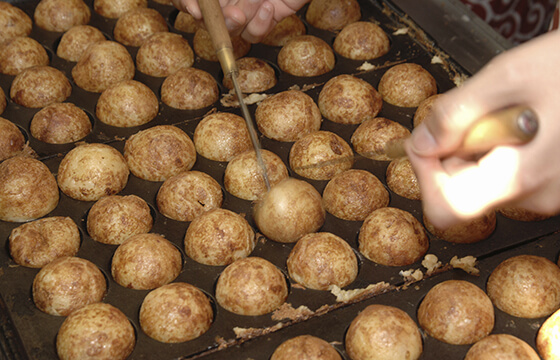
Takoyaki

Takoyaki has its roots in Hyogo's Akashiyaki (egg yaki), however Osaka has developed its own particular version.
(Osaka style is eaten with sauce, while Akashi style is eaten with dashi soup.) Either way, they are both lowed by all.
It is told that in mid 1930's, when octopus was easily caught in the inland sea, it was put in Osaka's takoyaki in order to copy the Akashi style.
Since there were many factories in downtown Osaka, teppan (griddle) were easily available.
With its smoky flavor from its dark sauce, the meal quickly spread amongst people of Osaka, and spread nationally by yatai, a mobile stand often seen at fairs.
Now there are three kinds of takoyaki - one with sauce, one without, and Akashiyaki.
Because of the depression, the "reasonable priced" takoyaki market has grown into a 150 billion yen market.
Takoyaki's filling, of course, includes, octopus.
60% of the world's octopus is consumed by Japanese, Kobe, Nara, Kyoto and Osaka - all in the Kansai area - are at the top of octopus consumption per household.
Kobe's consumption amounts to 150% of that of Tokyo's.
However, the amount of octopus caught in the inland sea is decreasing.
In 1963's great cold wave, the octopus catch was devastated and has only finally begun to come back in recent years.
Since 1965, when octopus fishing off the shores of Western Africa was cultivated, frozen octopus from abroad was the main source.
Today, that constitutes up to 70% of today's consumption.
The imported octopus vs the domestic one sees a great price difference at today's market.
Of course, there is a difference in taste, too.
The octopus from Akashi, because of the strong current, is lean with hard to chew texture, which brings out the most flavor.
Takoyaki may be the next item that Japan exports as a "fast food" and distribute worldwide.
(Osaka style is eaten with sauce, while Akashi style is eaten with dashi soup.) Either way, they are both lowed by all.
It is told that in mid 1930's, when octopus was easily caught in the inland sea, it was put in Osaka's takoyaki in order to copy the Akashi style.
Since there were many factories in downtown Osaka, teppan (griddle) were easily available.
With its smoky flavor from its dark sauce, the meal quickly spread amongst people of Osaka, and spread nationally by yatai, a mobile stand often seen at fairs.
Now there are three kinds of takoyaki - one with sauce, one without, and Akashiyaki.
Because of the depression, the "reasonable priced" takoyaki market has grown into a 150 billion yen market.
Takoyaki's filling, of course, includes, octopus.
60% of the world's octopus is consumed by Japanese, Kobe, Nara, Kyoto and Osaka - all in the Kansai area - are at the top of octopus consumption per household.
Kobe's consumption amounts to 150% of that of Tokyo's.
However, the amount of octopus caught in the inland sea is decreasing.
In 1963's great cold wave, the octopus catch was devastated and has only finally begun to come back in recent years.
Since 1965, when octopus fishing off the shores of Western Africa was cultivated, frozen octopus from abroad was the main source.
Today, that constitutes up to 70% of today's consumption.
The imported octopus vs the domestic one sees a great price difference at today's market.
Of course, there is a difference in taste, too.
The octopus from Akashi, because of the strong current, is lean with hard to chew texture, which brings out the most flavor.
Takoyaki may be the next item that Japan exports as a "fast food" and distribute worldwide.
TM © Rugby World Cup Limited 2015. All rights reserved.
)